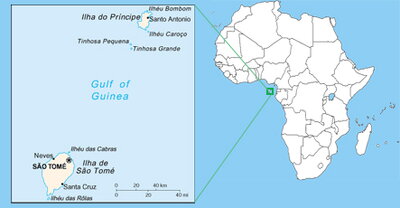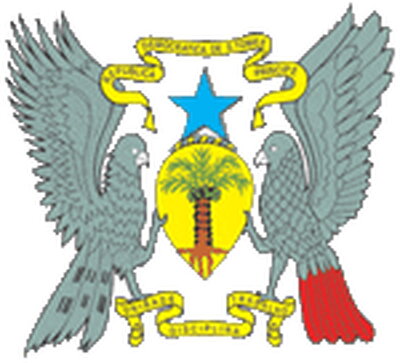

Region: Gulf of Guinea
Quick Facts:
- Population: 157,00
- Capital: São Tomé (also the largest city)
- Area: 372 sq miles. (About five times the size of Washington D.C.)
- Major Languages: Portuguese
- Life Expectancy: 62 years (men), 64 years (women)
- Literacy: 84.9%
- Monetary unit: 1 Dobra(STD) =100 centimos
- Exchange Rate: US $1= 14380 STD (January 8, 2009)
- Income (GDP) per capita: $1266 (constant 2000 international $, WDI 2005)
- Urban population: 57% of total population
- Paved roads: 68% of total road surface
- Electric Power Consumption (per capita): 1066 kWH
- Fixed line and mobile phone subscribers: 97 per 1,000 people
- Internet Users: 131 per 1,000 people
- Internet Domain: .st
- Country Code: +239
- Time Difference: GMT (6 hours ahead of Illinois during Standard Time)
- Climate: Tropical. Hottest month is March (82-90F ), coldest months are July-August (68-78F)
- Type of Government: Republic
- President: Fradique de Menezes
Historical Background:
One of Africa's smallest countries, Sao Tome and Principe is made of two islands and a number of smaller islets.
From the late 1400s Portugal settled convicts on Sao Tome and established sugar plantations with the help of slaves from the mainland. The colony gained independence after a political coup in Portugal in 1974. At first the Movement for the Liberation of Sao Tome and Principe was the country's only political party, but the 1990 constitution created a multi-party democracy. The island of Principe assumed autonomy in 1995.
Socio-political Background:
Sao Tome was amongst the first African countries to adopt a multi-party democracy in the early 1990s. Freedom of speech and press are guaranteed by the constitution and are upheld in practice.
President de Menezes, a cocoa exporter, was first elected in 2001, but the first four years of the regime were tumultuous, and included a week-long army coup in 2003. Nonetheless, de Menezes was re-elected with a significant majority in 2006.
Economy:
Sao Tome and Principe is trying to reduce its dependence on cocoa, which forms about 95 percent of its exports. Domestic food production does not meet domestic demand, so the country imports some food. Decreases in production and export prices have rendered the country heavily reliant on foreign aid. The government is encouraging economic diversification and is set to exploit the billions of barrels of petroleum which are thought to lie off the country's coast.
Drilling is under way and commercial production of petroleum is expected to begin within a few years. The Nigerian and Sao Tome governments entered into an exploration and production sharing agreement over the first of six different exploration blocs with a US dominated consortium. The contract allows a period of eight years for exploration and up to 20 years of production.
Promoters of tourism say the islands have plenty to offer visitors, but obstacles include limited knowledge of the country and poor air connections.
Trade Information:
- Exports: $4.9 million (1999 est.)
- Export Goods: Cocoa, copra, coffee, palm oil
- Main Export Partners (2005): Netherlands (51%), Germany (6%), Portugal (6%)
- Imports: $29.5 million (20005 est.)
- Import Goods: Machinery and electrical equipment, food items, petroleum products
- Main Import Partners (2005): Portugal (26%), France (18%)
Resources for Businesses:
Diplomatic Representation in the United States
Note: Sao Tome and Principe has no embassy in the US, but does have a Permanent Mission to the UN.
Chief of Mission: Domingos Augusto Ferreira
Address 122 East 42nd Street, Suite 1604,
New York, NY 10168
Telephone (212) 317 0533
Sao Tomé investors guide (pdf)

Last updated on 09/23/2009